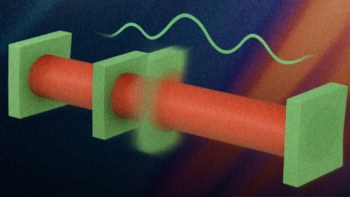
The radius of the proton is significantly smaller than previously thought, say physicists who have measured it to the best accuracy yet. The surprising result was obtained by studying “muonic” hydrogen in which the electron is replaced by a much heavier muon. The finding could mean that physicists need to rethink how they apply the theory of quantum electrodynamics (QED) – or even that the theory itself needs a major overhaul.
A proton contains three charged quarks bound by the strong force and its radius is defined as the distance at which the charge density drops below a certain value. The radius has been measured in two main ways – by scattering electrons from hydrogen and by looking very closely at the difference between certain energy levels of the hydrogen atom called the Lamb shift. Until recently the best estimate of the proton radius was 0.877 femtometres with an uncertainty of 0.007 fm
This Lamb shift is a result of the interactions between the electron and the constituent quarks of the proton as described by QED. These interactions are slightly different for electrons occupying the 2S and 2P energy levels and the resulting energy shift depends in part on the radius of the proton.
The heavier the better
However, in muonic hydrogen the Lamb shift is much more dependent on the proton radius because the much heavier muon spends more time very near to – and often within – the proton itself.
Now an international team led by Randolf Pohl at the Max Planck Institute for Quantum Optics in Garching, Germany has measured the Lamb shift in muonic hydrogen for the first time and found the proton radius to be 0.8418 fm with uncertainty 0.0007 fm. While this is by far the most precise measurement to date, it is in striking disagreement with previous measurements, being well outside the error bars of earlier results.
The team measured the shift using a proton accelerator at the Paul Scherrer Institute in Switzerland to create a beam of muons, which was then fired at hydrogen gas. Whenever a muon collides with a hydrogen molecule, it knocks the molecule apart and replaces the electron to create muonic hydrogen. About 1% of the time the muon finds itself in the 2S state, where it can be excited to the 2P state by absorbing a photon from a laser pulse. The 2P state then decays with the emission of an X-ray.
Complicated calculation
By counting the number of such X-rays while scanning the frequency of the laser pulse, the team could make a very precise measurement of the photon energy required to drive the 2S-2P transition. This is then fed into a complicated QED calculation to obtain the radius of the proton.
Pohl told physicsworld.com that the team has been working on the measurement for the past 12 years and got the first inklings of the anomalous result about six years ago. Since then, the researchers have reviewed, repeated and improved their measurements so that they are confident that the results are correct.
According to Jeff Flowers of the UK’s National Physical Laboratory there are three possible explanations for the discrepancy. The most likely is that QED is correct, but has been misapplied in what he describes as a “very difficult calculation”. Alternatively there is a problem with the experiment – but Flowers, who was not involved in the measurement, believes that Pohl’s team has done an excellent job. The least likely – but most exciting explanation – according to Flowers is that there is something wrong with QED.
‘Big philosophical change for physicists’
While QED rests on a weak mathematical foundation, it has been extremely successful in predicting the outcome of experiments. “Changing QED would be big philosophical change for physicists”, says Flowers.
The result has already caused a flurry of experimental and theoretical activity, with some physicists carefully redoing Lamb shift calculations and others trying to improve electron-based measurements of the proton radius.
Meanwhile, Pohl’s team will repeat its experiment and do a new series of measurements on muonic helium to measure the radius of the helium nucleus.
The research is described in Nature.



